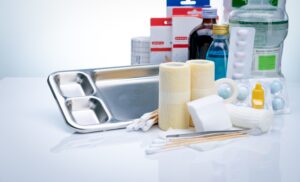Best Wound Dressings for Different Wound Types: A Nurse’s Guide

As a nurse, selecting the right wound dressing is crucial for promoting healing, managing exudate, preventing infection, and ensuring patient comfort. With countless options available, understanding how dressings align with specific wound characteristics can make all the difference in outcomes. This guide breaks down the best wound dressings for various wound types, focusing on evidence-based choices to help you optimize care plans. Whether handling acute injuries, chronic ulcers, or post-operative sites, these recommendations empower you to choose dressings that support moist wound healing while addressing unique challenges like drainage, tissue viability, and pain.
Understanding Wound Types and Dressing Principles
Wounds vary by etiology, depth, exudate level, and infection status, so no one-size-fits-all dressing exists. Key principles include maintaining a moist environment to facilitate healing, absorbing excess fluid to prevent maceration, and protecting against contaminants. Assess the wound’s tissue (necrotic, sloughy, granulating, or epithelializing), exudate (dry, scant, moderate, or copious), and surrounding skin before selecting. Always consider patient factors like allergies, mobility, and compliance. Regular reassessment ensures the dressing remains appropriate as the wound evolves.
Best Dressings for Dry or Necrotic Wounds
Dry wounds lack sufficient moisture, often leading to delayed healing, while necrotic ones feature dead tissue that requires debridement. Hydrogel dressings are ideal here, as they donate moisture to rehydrate the wound bed and promote autolytic debridement without causing trauma. Apply them to shallow, dry ulcers or donor sites, covering with a secondary film for retention. For deeper necrotic areas, combine with enzymatic agents if needed, but avoid in heavily exuding wounds to prevent leakage.
Best Dressings for Lightly Exuding Wounds
Wounds with minimal drainage, such as partial-thickness burns or early-stage pressure injuries, benefit from dressings that maintain moisture without overwhelming the site. Hydrocolloid dressings excel in this category, forming a gel-like barrier that absorbs light exudate while creating an occlusive seal to protect against bacteria. They’re self-adhesive, comfortable for patients, and can stay in place for several days, reducing dressing changes. Use them on clean, granulating wounds, but switch if maceration occurs around the edges.
Best Dressings for Moderately to Heavily Exuding Wounds
High-exudate wounds, like venous leg ulcers or deep surgical sites, require absorbent dressings to manage fluid and prevent skin breakdown. Alginate dressings, made from seaweed fibers, absorb up to 20 times their weight and form a gel to conform to the wound shape—perfect for cavity wounds or those with moderate drainage. For even heavier exudate, foam dressings provide cushioning and high absorbency, often with a silicone border to minimize pain during removal. Hydrofiber options offer similar benefits, gelling on contact to lock in fluid and support moist healing.
Best Dressings for Infected or Inflamed Wounds
Infected wounds show signs like increased pain, odor, or purulent discharge, demanding antimicrobial action alongside absorption. Silver-impregnated dressings release ions to combat bacteria, making them suitable for critically colonized or mildly infected sites without systemic antibiotics. Honey-based dressings provide natural antibacterial properties and osmotic effects to draw out exudate, ideal for sloughy or malodorous wounds. Iodine variants offer broad-spectrum coverage but use cautiously on sensitive skin. Always monitor for resolution and debride as needed to enhance efficacy.
Best Dressings for Superficial or Surgical Wounds
Superficial abrasions, skin tears, or clean surgical incisions need protection without bulk. Transparent film dressings are thin, breathable barriers that allow visual monitoring while shielding from friction and contaminants—great for low-exudate wounds or as a secondary over other dressings. Cloth or gauze options serve as basic coverings for minor cuts, often impregnated with paraffin to prevent adherence. For post-op sites with sutures, bordered low-absorbent films prevent leakage and support epithelialization.
Best Dressings for Chronic or Non-Healing Wounds
Chronic wounds, such as diabetic foot ulcers, often stall due to underlying factors like poor perfusion. Collagen dressings stimulate tissue regeneration by providing a matrix for cell growth, accelerating healing in granulating but slow-progressing wounds. Combine with compression for venous types or offloading for pressure-related ones. If biofilm is suspected, antimicrobial foams or alginates can disrupt barriers, but prioritize holistic management including nutrition and vascular assessment.
Conclusion: Tailoring Dressings for Optimal Wound Care
Choosing the best wound dressing involves matching the product’s properties to the wound’s needs, always prioritizing patient-centered care to minimize discomfort and complications. By mastering these selections, nurses can significantly improve healing times and quality of life. Stay proactive with assessments and education to refine your practice in this evolving field.
Ready to take your wound care expertise to the next level? Enroll in our upcoming Wound Care Certification Course (WCC Prep) at AppleTree CEU—designed for nurses like you to master advanced techniques and earn your certification. Available now! Enroll Here
